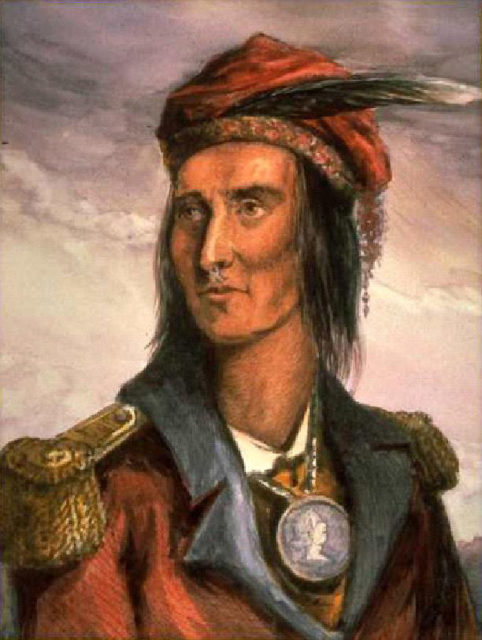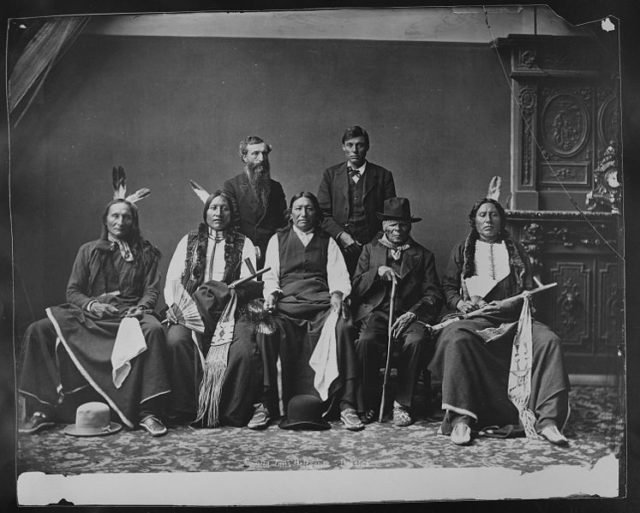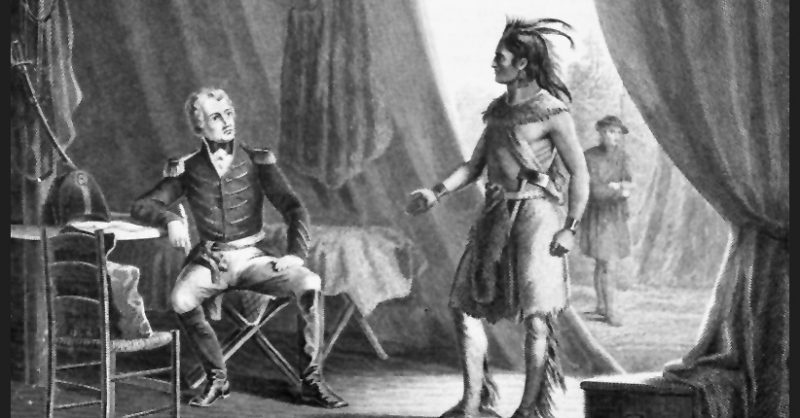Battles do not have to be vast to be significant. The Creek Indian War, which took place from 1813 to 1814, was a hard fought war between a faction of the Creek people known as the Red Sticks, and the encroaching power of the United States. It was a bloody period in history, and different Creek factions allied with the US forces against the Red Sticks. Over a series of battles involving dozens of men at the least to a few thousand at most, the Creek Red Stick rebels fought United States militiamen and their allies to decide the fate of Alabama, and of the Creek people.
The Battle of Burnt Corn
The first battle of the war was fought at Burnt Corn Creek.
Stirred up by the powerful Tecumseh, Red Sticks led by Peter McQueen – many of the Creek used European as well as native names – had raided white settlements. A small militia force led by Colonel Caller pursued and surrounded the raiders at Burnt Corn Creek. They almost destroyed the raiding force, but a failure to press their advantage let the natives take control of the battle. Poor discipline among the white soldiers led them to break, and Caller had to retreat.
The Fort Mims Massacre
The next battle was one of the most remarkable and most infamous of the war. Red Eagle, who would become the most famous rebel commander, led his men in an advance on Fort Mims. Through intelligence gathering and a careful approach they surprised the defenders and burst through the gate. Five hours of intense fighting followed in which the natives gained control of the fort. But Red Eagle then lost control of his troops, who massacred many of the inhabitants. The US mobilised troops in earnest to counter the Red Stick threat.

The Battle of Tallushatchee
Vengeance for Fort Mims came on the 3rd of November. Future President Andrew Jackson, leading the United States forces, ordered General Coffee to advance on enemy forces gathered at the town of Tallushatchee. Coffee surrounded the town, and when the Red Sticks advanced he forced them back in among their houses. The natives refused to surrender, and 168 were killed.
The Battle of Talladega
Not all the Natives sided with the rebels. A few days after Tallushatchee, a messenger reached Jackson telling him that 150 friendly Natives were besieged at Tallushatchee by 1,000 Red Sticks. Jackson marched his force upon the town and defeated the besiegers, killing nearly 300. Jackson’s tactic of withdrawing in the centre might have been more effective had some of his men not fallen into a real retreat.
The Battle of the Canoes
Captain Sam Dale, wounded at Burnt Corn Creek, was one of the most notable American soldiers of the war. On his return to action in November 1813, he led an expedition to look for Red Stick raiders.
Dale’s small force was attacked while crossing a river. Dale and a dozen of his men were trapped alone on the bank they had been leaving. Red Stick warriors attacked his party from the woods and others came at him in a canoe on the river. Dale and his men captured the canoe in brutal close-quarters fighting and completed their crossing under fire.
The Battle of Autosse
On the 29th of November, General Floyd tried to imitate others’ successes by surrounding and destroying a native force in the town where it was based, this time at Autosse. Unlike Coffee, he failed to surround his target. Though American troops won by using artillery and cavalry, the remains of the native force were able to escape. Floyd, low on supplies, had to withdraw, harassed by the surviving natives.

The Battle of the Holy Ground
The Holy Ground was a new Creek town on the eastern bank of the Alabama River. Though fortified, it was not able to stand against the forces under General Claiborne that attacked on the 23rd of December.
The natives, led by Red Eagle, were well prepared and managed to evacuate in the face of the American threat. Uneven ground prevented an effective pursuit, and Red Eagle himself escaped capture by leaping on horseback from a high bluff, landing in the river and swimming across.
The Battle of Emuckfau
After Christmas, Jackson began an advance whose results would be disputed by the opposing sides – he claimed successes, while natives claimed to have driven him off.
The first encounter of this campaign took place on the 22nd of January, 1814, near the fortified native town of Emuckfau. Rebel troops fell upon Jackson’s column before it could reach and assault the town. Fierce fighting on the American right proved to be a feint by the natives, who fell upon and almost pushed back the American left. Solid work by Jackson and by Coffee, commanding the right, held the line. But while they held the field, they never reached Emuckfau.
The Battle of Enotachopca
After Emuckfau, Jackson began a retreat towards his base. The Red Sticks attacked him at Enotachopca and were again driven off, allowing him to complete his retreat.
Jackson had held the field twice, with far fewer losses than his enemies. But he had been driven back, a dent to American confidence.
![By Unknown - The New York Public Library, Digital Gallery [1], Public Domain, https://commons.wikimedia.org/w/index.php?curid=20745420](https://www.warhistoryonline.com/wp-content/uploads/sites/64/2016/07/Battle_Horseshoe_Bend_1814-576x640.jpg)
The Battle of Calebee Creek
On the morning of the 27th of January, Red Eagle led an assault on Americans under General Floyd at Calebee Creek. Attacking silently out of the swamps under cover of darkness, they caught the US soldiers by surprise, forcing them onto the defensive.
But when dawn came, Floyd was able to organise his troops and swing his flanks around. They nearly surrounded the attackers, and Red Eagle withdrew.
Like Jackson, Floyd had the battlefield victory, but the strategic loss. His confidence was broken, and he withdrew.
The Battle of Tohopeka
Despite these successes, the Creek rebels were steadily driven back. At last, their main force was trapped by Jackson at Tohopeka. On the 27th of March 1814, in a battle also known as the Battle of Horseshoe Bend, they fought a last desperate defence of their fortified position there. A costly assault by Jackson led to the storming of the native defences, with hundreds killed. Many natives fought to the death rather than surrender. Some escaped across the river.
On August 9th, Andrew Jackson brought the Creek chiefs to terms with the Treaty of Fort Jackson, which ended the war and transferred a huge amount of Creek land into the control of the US Government. Having fought off the threat of the Red Sticks, Jackson kept his momentum, moving quickly against Spanish and British interests nearby
